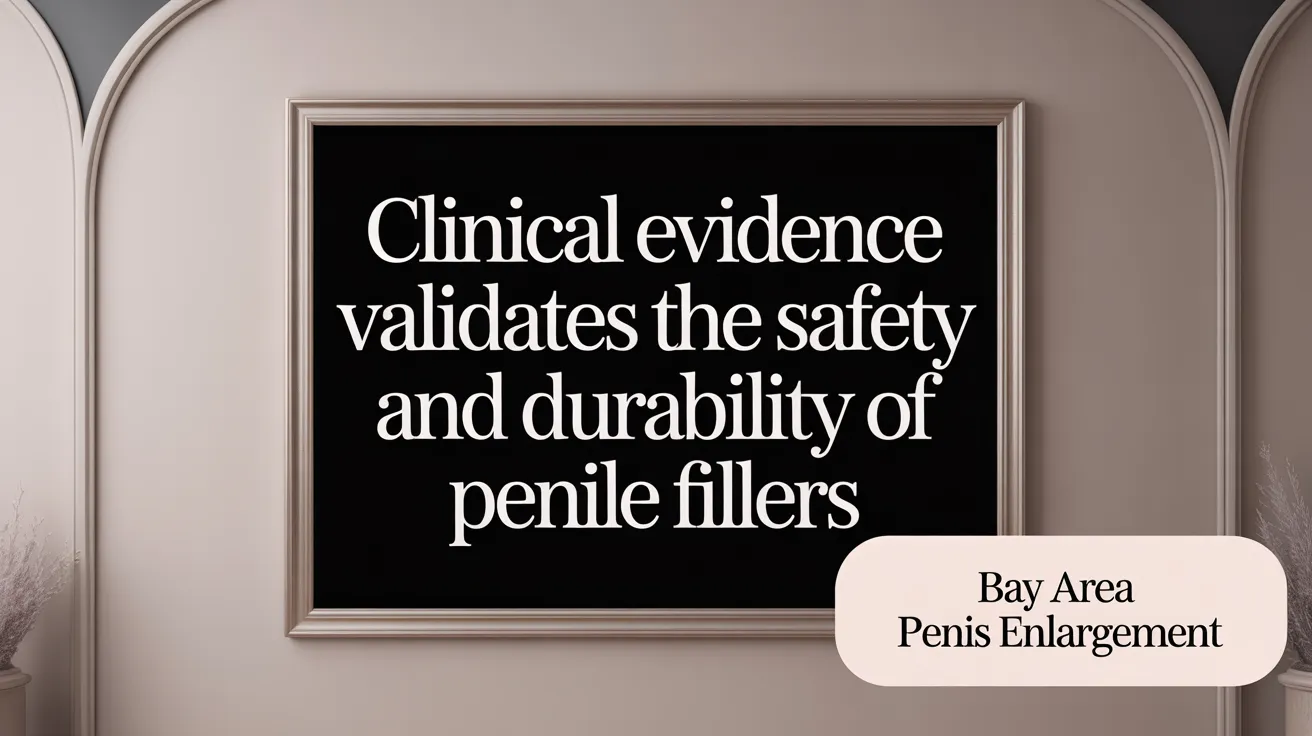Understanding the Real Impact of Male Enhancement
Male enhancement procedures have gained significant attention as men seek ways to improve their self-confidence and sexual satisfaction. With a variety of treatment options available—from non-surgical fillers to advanced implants—understanding the success rates and patient experiences is essential. This article examines the scientific evidence, reported outcomes, and personal testimonials to shed light on the psychological and physical effects of penile augmentation techniques.
Measured Effectiveness of Penile Girth Enhancement Techniques

What are the measurable girth increases from various penile girth enhancement methods?
Penile girth enhancement techniques, especially injectable fillers, have demonstrated measurable and consistent increases in girth. Among these, hyaluronic acid (HA) fillers are well-studied, with average girth increases reported around 3.29 cm, which is at the high end of documented gains in scientific literature. These increments are considered significant and have been confirmed by clinical trials with rigorous designs.
Other fillers such as polylactic acid (PLA) and polymethyl methacrylate (PMMA) injections also show similar girth enhancements. PLA injections often yield average gains of approximately 2.7 to 3.2 cm, and PMMA injections provide increases in the range of 2.4 to 3.5 cm. Comparative studies suggest both HA and PLA fillers offer comparable results in terms of girth improvement.
How safe and tolerated are these injectable materials?
Safety profiles for these fillers show minimal serious complications. Both HA and PLA fillers are associated with transient, mild adverse effects such as injection site reactions, but no severe adverse events have been reported in controlled studies. PMMA injections carry some risks of irregularities like nodularity but remain manageable with high patient satisfaction rates as detailed in current penile enhancement research.
Additionally, these injectable treatments may provide further benefits beyond size enhancement, such as improvements in sexual satisfaction and ejaculation control in some cases. Their reversibility and relatively low risk make them attractive options compared to more invasive surgical procedures, as supported by patient outcome studies.
Clinician-measured girth increases post-injection confirm these findings, often showing average flaccid girth increases nearing 12.7 cm or more after treatment. Despite continued psychological perceptions of penis size being less than ideal in some men, the actual anatomical changes are objectively measurable and impactful, as reviewed in psychological and clinical outcomes research.
In summary, penile girth enhancement through injectable fillers like hyaluronic acid and polylactic acid demonstrates an effective average increase of 2.3 to 3.8 cm, combining sound safety profiles and patient satisfaction.
Psychological Outcomes Following Penile Augmentation

How do penile enhancement procedures impact psychological well-being?
Penile girth augmentation has been shown to positively impact psychological well-being for many men. Approximately half of the men who underwent the procedure reported increased self-confidence and greater sexual pleasure afterwards. These enhancements in self-perception contribute notably to their overall sense of personal satisfaction (Men's positive impacts after penile girth augmentation).
Effects on self-confidence and sexual pleasure
After penile girth augmentation, about 47% of men experienced an increase in self-confidence. Furthermore, around 42% reported improved sexual pleasure following the procedure, highlighting psychological and sensory benefits tied to physical changes (Men's increased self-confidence after penile girth augmentation.
Changes in body image perception
Though men’s average penile girth increased significantly—by about 3.29 cm, which is at the upper end for such treatments—many still viewed their penis size as smaller than their personal ideal. However, the gap between perceived and ideal size was significantly reduced post-procedure, indicating an improved body image even if perfect satisfaction was not universally achieved (Average penile girth increase of 3.29 cm.
Body dysmorphic disorder prevalence and changes post-procedure
Before surgery, roughly 11% of men met criteria for body dysmorphic disorder (BDD), a condition involving distress and preoccupation with perceived flaws. Remarkably, no patients met BDD diagnostic criteria six months after the procedure, suggesting the surgery may alleviate some symptoms or diminish the intensity of the disorder in select cases (Reduction in body dysmorphic disorder symptoms.
Limitations on broader psychological changes
Despite these localized improvements, broader psychological outcomes such as overall psychological distress, general self-esteem, and body image-related quality of life did not show significant change after penile girth augmentation. This underscores that while the procedure may impact specific self-perceptions related to penile size, it does not inherently address wider mental health or self-image issues (No significant changes in psychological distress or self-esteem.
This evidence highlights that penile augmentation can be a beneficial option for men seeking to improve self-confidence and sexual satisfaction, with important caveats regarding realistic expectations and psychological support (Men's perceptions of penile size post-augmentation.
Surgical and Non-Surgical Methods: Comparative Success and Risks

Overview of Surgical Modalities
Surgical penile enhancement typically includes autologous fat injections, dermal fat grafting, suspensory ligament release (ligamentolysis), and penile implants such as the Penuma® silicone device — the only FDA-approved cosmetic implant for this purpose. Fat and dermal grafts can increase penile girth significantly, sometimes by around 2–3 cm or more, and the Penuma implant may increase girth by up to 5 cm with high patient satisfaction. Ligamentolysis may improve apparent flaccid length but does not increase erect length and carries risks such as scarring and erectile dysfunction (source).
Non-Surgical Options
Non-surgical methods include injectable fillers like hyaluronic acid (HA) and polylactic acid (PLA), vacuum erection devices (VEDs), and traction therapy. HA injections provide an average girth increase of about 2.3 to 3.8 cm with minimal downtime and safety risks (source). VEDs tend to offer little actual increase in length or girth but may improve psychological satisfaction (source). Traction therapy can cause modest increases in penile length (around 1 to 1.7 cm) with a good safety profile but limited effect on girth (source.
Patient Satisfaction and Complications
Surgical methods generally show higher satisfaction due to more pronounced girth increases but carry risks including infection, scarring, loss of sensation, erectile dysfunction, and the potential need for revision surgery (source). Non-surgical procedures tend to have fewer serious adverse effects and shorter recovery, though gains may be less dramatic and sometimes temporary. Complications are rare with injectable fillers but severe complications have been reported with certain substances like liquid silicone (source).
FDA Approval and Safety Considerations
Currently, the Penuma penile implant is the only FDA-approved device specifically for cosmetic penile girth enhancement. Many other surgical and non-surgical approaches lack formal approval and standardized protocols (source. Users are cautioned about non-medical products like creams or unregulated devices, as most lack evidence supporting efficacy and carry potential risks (source).
In summary, surgical enhancement delivers more substantial and lasting increases in penile girth but has a higher risk profile, while non-surgical options offer moderate improvements with better safety and minimal recovery time. Choosing a method requires careful consideration of patient expectations, health status, and psychological factors (source.
Patient Testimonials Highlighting Personal Benefits and Experiences
What do male enhancement patients say about their experiences and outcomes?
Many men undergoing penile enlargement procedures share personal stories of significant positive change. For example, one patient highlighted how the procedure transformed his life by boosting his confidence and enhancing his overall enjoyment of life. Such powerful testimonials underline the psychological as well as physical benefits.
Another patient detailed his journey, appreciating the thorough consultation process and the professionalism of the clinic staff. He described how the surgery positively affected his personal relationships, suggesting benefits that extend beyond the physical alterations.
In addition to patient voices, medical professionals have also voiced support. A doctor from Germany praised the surgeon's exceptional skills and high standards, lending credibility to the quality of care offered at reputable clinics.
Together, these patient testimonials paint a picture of enhanced self-image and improved emotional wellbeing alongside measurable improvements in girth and appearance, demonstrating the procedure's impact beyond purely physical outcomes.
Clinical Trial Evidence Supporting Safety and Durability of Fillers

What clinical evidence supports the safety and effectiveness of penile filler treatments?
Randomized, patient and evaluator-blinded clinical trials have provided robust evidence on the efficacy and safety of penile girth enhancement using fillers like hyaluronic acid (HA) and polylactic acid (PLA). One multicenter trial involving 64 male participants showed an average penile girth increase of approximately 22.7 mm in the HA group and 20.2 mm in the PLA group at 24 weeks post-treatment. This significant increase was objectively measured by clinicians, confirming the physical effectiveness of the procedure.
Patients reported higher satisfaction levels concerning penile appearance and sexual life after receiving filler injections. Beyond girth enhancement, these trials also noted improvements in premature ejaculation symptoms, demonstrated by increased intravaginal ejaculation latency times (IELT) correlating with enhanced sexual performance.
Importantly, no serious adverse events were reported in these studies. Mild, transient injection site reactions were the only observed side effects and resolved without intervention. This safety profile supports the notion that hyaluronic acid and polylactic acid fillers are well tolerated.
These findings validate fillers as a safe, effective, and durable option for penile girth augmentation, with measurable physical improvement and positive patient-reported outcomes maintained for at least six months post-procedure.
Addressing Psychological Motivations and Managing Expectations

How do psychological factors influence male enhancement and patient satisfaction?
Many men who seek penile enhancement actually have normal-sized penises but suffer from psychological distress related to their perception of size. This distress is often labeled as small penis anxiety or penile dysmorphophobia. These conditions reflect a distorted body image rather than a physical deficiency.
Psychological drivers such as low self-esteem, anxiety about sexual performance, and socially influenced ideals about penis size motivate men to pursue enhancement procedures. Studies show that up to 11% of men seeking augmentation may meet criteria for body dysmorphic disorder (BDD), though this prevalence decreases after interventions.
The role of psychological assessment pre-procedure
Before undergoing enhancement treatments, psychological evaluation is critical. Assessments help identify patients with unrealistic expectations or underlying disorders like BDD, which may not be resolved by surgery alone.
Addressing these psychological aspects before treatment ensures that patients understand the potential outcomes and risks, reducing dissatisfaction and improving postoperative confidence. Psychological support or therapy may be recommended alongside or instead of physical procedures to address deep-seated concerns (source.
Importance of realistic expectations
Setting realistic goals about what penile enhancement can achieve is essential. Although procedures like hyaluronic acid injections can increase girth by approximately 2.3 to 3.8 cm and improve self-confidence, many men still perceive their size as smaller than their ideal after treatment.
Education about the natural variability in penis size and the limits of enhancement reduces the risk of unmet expectations. Combining medical treatment with psychological care offers the best chance for satisfaction and improved quality of life (more details.
Emerging Technologies and Future Directions in Penile Augmentation
What promising new methods are being developed for penile enhancement?
Modern penile augmentation is evolving with promising new methods that leverage advanced biomedical techniques.
One notable development is tissue engineering using biodegradable scaffolds seeded with autologous cells. This approach has shown mean girth increases around 3.15 cm while maintaining a low rate of complications. By integrating body-compatible materials that support natural tissue growth, these scaffolds offer steady penile girth enhancement with aesthetic and functional improvements. This technology also addresses limitations common to traditional fat grafting and filler injections.
Innovations in implant design include improved materials and shapes that enhance safety and patient satisfaction. The Penuma silicone implant is a leading example; it has gained FDA approval and provides significant girth enhancement with high satisfaction rates and manageable complication profiles. Advances focus on reducing risks like infection or device erosion while yielding natural appearance and feel.
Combined, these advances aim to improve the safety profile, durability, and visual and tactile outcomes of penile augmentation procedures. They may reduce the incidence of adverse effects seen with earlier surgical or injectable methods, such as scarring, irregularities, or material migration.
Overall, these emerging technologies represent a shift toward more predictable, long-lasting, and natural penile enhancement strategies, offering realistic options for men seeking improvement beyond conventional methods.
Functional and Sexual Benefits Beyond Size Increases
Besides girth increase, what other benefits do patients experience?
Men undergoing penile girth augmentation often report benefits that go beyond simple size enhancement. Almost half of patients express increased sexual pleasure following the procedure, highlighting improved physical enjoyment during intimacy. Additionally, gains in self-confidence accompany these changes, contributing to psychological well-being (Men's positive impacts after penile girth augmentation.
Improvement in sexual pleasure and ejaculation control
Clinical trials reveal that penile enhancement procedures, especially those involving hyaluronic acid or polylactic acid fillers, can significantly improve ejaculation control. Both filler types have been associated with increased intravaginal ejaculation latency time (IELT), with patients reporting mean IELT increases from roughly 5.3 minutes to nearly 7.9 minutes post-treatment (Penile Girth Enhancement Clinical Trial). This suggests that these treatments may provide relief for premature ejaculation symptoms by reducing tactile sensitivity of the penile shaft.
Clinical findings on intravaginal ejaculation latency time
Studies involving penile girth enhancement consistently demonstrate an extended IELT after intervention. Such findings are clinically meaningful as they indicate improved sexual function and control. Notably, these benefits appear without serious adverse events, emphasizing the safety profile of filler-based augmentation (Penile girth enhancement with hyaluronic acid filler).
Patient-reported quality of life changes
Beyond physical and functional gains, patients report enhanced sexual life satisfaction after penile girth enhancement. Satisfaction with penile appearance improves significantly, and the reduction in premature ejaculation symptoms further contributes to a better quality of life. While broader measures of psychological distress and self-esteem may not show dramatic changes, enhanced sexual confidence fosters improved personal and relational well-being (Men's experiences with penile girth augmentation.
These collective improvements reveal the holistic nature of penile enhancement procedures. They extend beyond mere cosmetic changes to include meaningful functional and psychological benefits that enhance overall sexual health and quality of life.
Balancing Risks and Rewards: Informed Patient Decision-Making
What risks should patients be aware of when considering male enhancement procedures?
Patients considering penile enhancement procedures face several potential complications. Surgical interventions come with risks such as infection, scarring, sensory loss, erectile dysfunction, and dissatisfaction with the aesthetic result. More serious surgical complications can include penile deformities, tissue reabsorption, granuloma formation, and sometimes the necessity for additional corrective surgeries. For more detailed information, see Penile enlargement surgical methods and risks and Psychological dysmorphism in penile size perception and surgical complications.
Non-surgical treatments, including injections of hyaluronic or polylactic acid fillers, generally have lower complication rates but require professional administration to minimize risks. However, permanent fillers and substances like silicone injections carry severe risks including embolism and tissue necrosis. Learn more about Nonsurgical penile enhancement treatments, including hyaluronic acid injections and associated risks and Penile enhancement safety and satisfaction.
Why is a thorough preoperative evaluation necessary?
Before undergoing any enhancement procedure, a detailed preoperative assessment is critical. This evaluation includes physical health checks and psychological screening to identify conditions like body dysmorphic disorder or small penis anxiety that heavily influence patient satisfaction. Relevant guidance can be found in Psychological motivations and patient selection in penile enlargement and Body dysmorphia and penis size considerations.
Such assessments help practitioners determine whether the patient’s goals are realistic and if they are suitable for surgical or non-surgical intervention, reducing the chance of postoperative dissatisfaction or psychological distress. For more on patient evaluations and psychological factors, see Pre-surgery evaluations and expectations.
What are the postoperative care and recovery expectations?
Recovery after surgery varies with the type and extent of the procedure but may require up to six weeks before resuming sexual activity fully. Patients are advised to follow strict postoperative care guidelines to reduce infection risk and promote healing. Detailed information on Penis enlargement surgery recovery and postoperative care provides useful insights.
For nonsurgical fillers, follow-up appointments monitor outcomes and manage any mild side effects. Reliable patient education on postoperative expectations helps enhance satisfaction and minimize complications. See also Clinical benefits and safety of penile girth enhancement fillers.
How do ethical considerations and professional guidance influence patient care?
Ethically, many medical societies caution against cosmetic penile enlargement procedures in men with anatomically normal penises, emphasizing that dissatisfaction often arises from perception rather than physical necessity. For a comprehensive overview, refer to Ethics and medical society guidelines on penis enlargement and American Urological Association recommendations.
Healthcare providers are encouraged to provide multidisciplinary care, including psychological counseling, to ensure informed decision-making and realistic expectations. This guidance helps balance the benefits of increased confidence against the potential physical risks. For professional recommendations and psychological aspects, see Multidisciplinary approach and psychological benefits of penile enhancement.
Through careful patient selection, thorough evaluation, and professional oversight, men can better navigate the complex decision of penile enhancement while mitigating risks and optimizing psychological and physical outcomes. Additional evidence on psychological and satisfaction outcomes after penile girth augmentation is available at Men's psychological outcomes and satisfaction studies.
Synthesis of Patient Outcomes and Clinical Insights
Male enhancement procedures encompass a range of surgical and non-surgical options that achieve measurable increases in penile girth, generally around 2 to 3.8 cm, supported by clinical evidence. Patients frequently report psychological benefits such as increased self-confidence and improved sexual satisfaction, which correlate with objective size gains. However, underlying psychological conditions like body dysmorphic disorder must be carefully assessed and managed to ensure satisfactory outcomes. Testimonials affirm the positive impact on personal wellbeing, while risks and complications remain considerations guiding clinical practice. Emerging technologies, including tissue engineering and advanced implants, offer promising future solutions. A multidisciplinary and ethical approach is vital to optimize results, align patient expectations, and ensure safety in male enhancement treatments.

